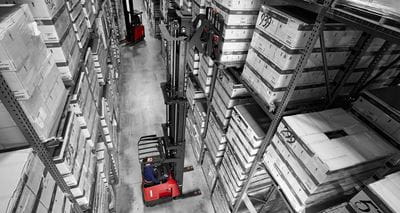How To Calculate A Forklift Aisle Width Minimum

Although you should always verify your calculations with your Raymond West advisor, you can start with a simple formula to figure out how much aisle space your forklift will require.
When selecting the right forklift for your business, you must consider several factors that are unique to your application. There's a lot to think about, from determining basic questions like IC vs electric, to calculating the proper rated capacity and lift heights. Not to mention the actual physical space of your facility--are your aisles wide enough to accommodate a specific lift truck?
Calculating the minimum aisle width is an important step in determining which forklifts to consider purchasing. With some basic math, it’s easy to determine your minimum aisle requirements.
Calculating Minimum Aisle Width
Although you should always verify your calculations with your Raymond West advisor, you can start with a simple formula to figure out how much aisle space your forklift will require. It starts with a specification called “Right Angle Stacking Width” that you can get from the manufacturer for any forklift model.
Using that specification, you can calculate the minimum aisle width this way:
Right Angle Stacking Width +
Maximum Load Length +
Clearance (12 inches) =
Minimum Aisle Width
Right Angle Stacking Width is the absolute minimum amount of space required for a forklift to turn and enter a pallet. However, it doesn’t account for the length of the load being handled or any additional clearance, so you need to factor those two items in.
Load length can vary quite a bit depending on what products you’re handling. If you only use standard GMA pallets you can use a load length of 48 inches, but if you handle long or bulky goods, adjust accordingly.
Clearance is your “allowance for error” when handling goods within an aisle. Twelve inches is generally considered to be a safe and reasonable operating clearance.
Putting It All Together
To illustrate the concept, let’s use an example. Let’s say that you are considering a stand up counterbalance lift truck with a Right Angle Stacking Width of 66.3 inches. Let’s also assume that your operation handles standard pallets that are 48 x 42 inches.
Your calculation would be 66.3 inches for the truck + 48 inches for the width of the pallet + 12 inches for clearance, for a total of 126.3 inches, or 10.525 feet.
It’s important to understand that you can use these calculations as a guideline, but you should always consult with a material handling expert before making a purchase. If you have questions about buying a new or used forklift, contact a professional at Raymond West today!

